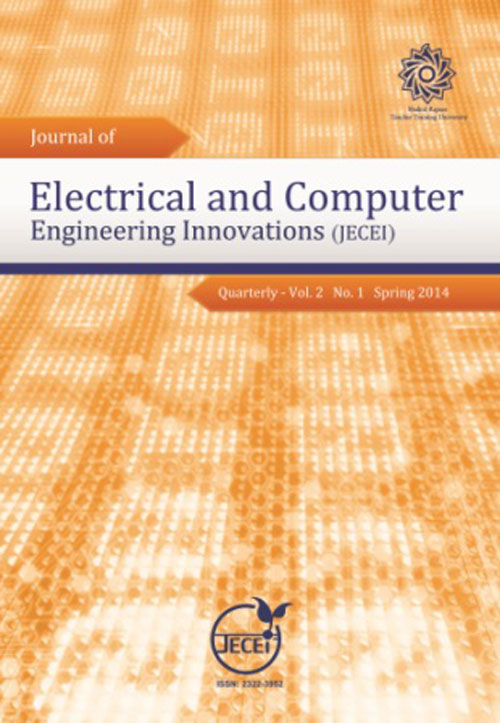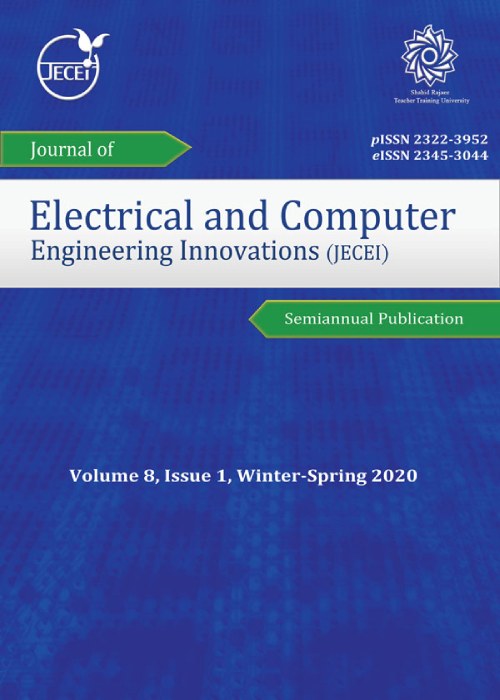فهرست مطالب

Journal of Electrical and Computer Engineering Innovations
Volume:4 Issue: 2, Summer-Autumn 2016
- تاریخ انتشار: 1395/12/23
- تعداد عناوین: 10
-
-
Pages 103-108Data analysis in cardiovascular diseases is difficult due to large massive of information. All of features are not impressive in the final results. So it is very important to identify more effective features. In this study, the method of feature selection with binary cuckoo optimization algorithm is implemented to reduce property. According to the results, the most appropriate classification for support vector machine is featured diagnoses heart disease. The main purpose of this article is feature reduction and providing a more precise diagnosis of the disease. The proposed method is evaluated using three measures: accuracy, sensitivity and specificity. For comparison, a data set of Machine Learning Repository database including information about 303 people with 14 features was used. In addition to the high accuracy of current methods, are expensive and time-consuming. The results indicate that the proposed method is superior on other algorithms in terms of Performance, accuracy and run time.Keywords: Heart Disease, Support Vector Machine, Binary Cuckoo Optimization, Algorithm, Features Selection
-
Pages 109-115The replacement of steam catapults with electromagnetic ones is becoming an overwhelming trend in aircraft launch systems. The Electromagnetic Aircraft Launch System (EMALS) offers significant benefits to the aircraft, ship, personnel, and operational capabilities. EMALS has such advantages as high thrust, good controllability, reusable, etc., as a launching motor, a double-side plate Permanent Magnet Linear Synchronous Motor (PMLSM) can provide high instantaneous thrust. This paper compared two PM mover with quasi-Halbach array topology and radial topology for PMLSM application. A detailed analytical modeling based on Maxwell equations is presented for analysis and design of PMLSM with Halbach array. Finally, employing 2-D nonlinear time-stepping transient finite element method to demonstrate validity of the analytical analysis and parametric search. Using FEA, the effects of the parameters on the thrust amplitude are analyzed. Finally, A design optimization method applied to PMLSM with Halbach array, that the obtained result form 2-D FEM shown the increase of thrust force and flux density distribution in the air gap.Keywords: EMALS, FEM, Radial Array, HalBach Shaped Magnets, PMLSM
-
Pages 117-124To distinguish between human user and computer program to enhance security, a popular test called CAPTCHA is used on Web. CAPTCHA has an important role in preventing Denial Of Service (DOS) attacks in computer networks. There are many different types of CAPTCHA in different languages. Due to the expansion of Persian-language and documents on internet, creating a suitable Persian CAPTCHA seems to be necessary. In this paper, we introduce three different types for Persian CAPTCHA in different domains. In the first type, based on the particular characteristics of Persian writing such as contiguous writing and image processing techniques, high strength CAPTCHA is provided. In the second type, the meaning of Persian words are used to creating CAPTCHA and in the third type, the combination of image processing techniques and the meaning of Persian words are used. Experimental results show that proposed CAPTCHAs has high security against attacks while Persian people can easily recognize them.Keywords: CAPTCHA, Persian Language, Persian CAPTCHA, Image Processing
-
Pages 125-133Low scaling technology makes a significant reduction in dimension and supply voltage, and lead to new challenges about power consumption such as increasing nodes sensitivity over radiation-induced soft errors in VLSI circuits. In this area, different design methods have been proposed to low power flip-flops and various research studies have been done to reach a suitable hardened flip-flops. In this paper we combined these two generally separate addressed issues to reach a new low power high reliability flip-flop (LP-HRFF). LP-HRFF operates over 1GHz clock frequency and structured based on an appropriate combination of dual interlocked storage cell, level converting techniques and clock signal controlled gates. The extensive simulations exhibit LP-HRFF has 0% single event upset rate against single transient events occurred on inputs and internal nodes and show the improvement of power consumption up to 42.8% and power delay product up to 24.6% when compared with its counterparts. Furthermore, the simulation results approve the robustness and efficiency of the proposed flip-flop against process variations.Keywords: Low Power Design, Hardened Flip, flop, Soft Error, Dual Inter locked Storage Cell, Level Converting Technique
-
Pages 135-146In this article a new method is introduced for geolocating of signal emitters which is based on evolutionary computation (EC) concept. In the proposed method two well-known members of EC techniques including Bees Algorithm (BA) and Genetic Algorithm (GA), are utilized to estimate the positions of emitters by optimizing the hyperbola equations which have been resulted from Time Difference of Arrival (TDOA) of their radiated signals. To show the effectiveness of the EC concept in positioning the simulation is carried for linear and nonlinear moving emitters in presence of several amounts of noise. Then obtained results are compared with Maximum Likelihood (ML) estimator as one of the most common approaches among traditional methods. The results showed better performance of the EC family compared to ML in such way that they estimate the position of emitters even up to 33% and 30% more accurate than ML in presence of 5 and 10 percent of noise respectively. Furthermore the comparison among the examined methods belong to EC family shows that BA leads to the accuracy of 3 to 12 percent better than GA in estimating positions of radiation sources.Keywords: Time Difference of Arrival (TDOA), Geolocation, EC Paradigm, Bee Algorithm (BA), Genetic Algorithm (GA)
-
Pages 147-153The problem of attitude stabilization of a fighter aircraft is investigated in this paper. The practical aspects of a real physical system like existence of external disturbance with unknown upper bound and actuator saturation are considered in the process of controller design of this aircraft. In order to design a robust autopilot in the presence of the actuator saturation, the Composite Nonlinear Feedback (CNF) controller along with the Adaptive Integral Sliding Mode (AISM) controllerand the new robust controller that is called AISM-CNF control law is proposed. The CNF part of controller is used for stabilization of the nominal system and also improvement of the transient performance by considering the actuator saturation. The AISM part guarantees robustness against the model uncertainties and/or external disturbances. Since in the proposed approach, the upper bound of the uncertain terms is estimated and therefore there is no need to the prior knowledge of the upper bound of the model uncertainties. Finally, simulation results show the performance of the proposed AISM-CNF controller in term of attitude stabilization of fighter aircraft, robustness, and the good characteristics of the transient responses of the autopilot system in spite of actuator saturation and external disturbance.Keywords: Fighter Aircraft, Input Constraints, Composite Nonlinear Feedback (CNF), Adaptive Integral Sliding Mode (AISM)
-
Pages 155-165Using IEC 61850 standard would increase the reliability and availability of electricity network and put a huge impact on network automation. Even though much research works has been done in substation system reliability, there is a few works in automated substation control system reliability. This paper evaluates the reliability of substation automation system based IEC 61850 comparatively considering vender's different intelligent electrical devices. The technique is based on fault tree analysis approach and the tie sets methodology is used to evaluate quantitatively. In this paper proposed method is implemented on Mianeh Aydoghmush substation automation system in 5 different scenarios. Comparative studies are used to establish the most reliable architecture compared with others. Using IEC 61850 Standard in substation automation system provides us to use different manufacturers products with identical protocols. Furthermore, producers different intelligent electrical devices, in 3 different ranges of mean time between failures, are tested in various scenarios and reliability of system is evaluated quantitatively. Proposed method provides rate of change of system mean time to failure index. Using this index can be a useful tool to choose the best range of intelligent electrical devices.Keywords: IEC 61850, Substation Automation System, Fault Tree Analysis, Mean Time Between Failure, Rate of Change of System Mean Time to Failure
-
Pages 169-176Suppression of noise and artifacts is a necessary step in biomedical data processing. Adaptive filtering is known as useful method to overcome this problem. Among various contaminants, there are some situations such as electrical activities of muscles contribute to impulsive noise. This paper deals with modeling real-life muscle noise with α-stable probability distribution and adaptive filtering noise cancellation assessment with maximum correntropy criterion (MCC) as adaptive technique. Based on our test on some data of MIT-BIH arrhythmia and EMBC databases, we achieve an improved SNR in any electrocardiogram (ECG) signal corrupted by impulsive noise. The worst achieved improvement based on setting the best parameter values using trial and error for both filter and utilized algorithm is 9.5 dB with correlation coefficient value of 0.93. The SNR improvement on the whole utilized database records is 11.03 dB on average. The proposed algorithm is applied to the records from MIT-BIH arrhythmia and EMBC databases to remove the impulsive noise. A computer simulation is used to create and add it to the ECG signals. Simulation results are also provided to support the discussions.Keywords: Adaptive filtering, Impulsive noise, Maximum correntropy, ECG signal, Noise cancellation
-
Pages 177-184This paper considers solving optimization problem for linear discrete time systems such that closed-loop discrete-time system is positive (i.e., all of its state variables have non-negative values) and also finite-time stable. For this purpose, by considering a quadratic cost function, an optimal controller is designed such that in addition to minimizing the cost function, the positivity property of the optimal state trajectory of the closed-loop system is also guaranteed. Furthermore, state variables of the closed-loop system converge to the origin in finite steps (finite-time stability). In this regard, the LQR+(positive LQR) problem for the linear discrete time systems is stated. Once, the cost function with finite-time horizon is considered and another time the cost function with infinite-time horizon is assumed. In this regard, two theorems are given and proved which consider the problem of building positive and also optimize of the linear time-varying discrete time systems. Results can also be applied to linear time-invariant discrete time systems. Finally, computer simulations are given to illustrate effective performance of the designed controller and also verify the theoretical results.Keywords: LQR+ problem, Discrete-time positive linear systems, Optimal control, Finite-time stabilization, State constraints
-
Pages 185-193This paper deals with the modeling, analysis, design and simulation of a robust control method for a permanent magnet synchronous machine (PMSM) supplied with a PWM inverter based on a LPV (Linear Parameter Variation) standard controller. Under the influence of uncertainties and external disturbances, by a variation of ±150% of motor parameters from the nominal values, the robust performance control problem is formulated as a LPV standard scheme and solved by a suboptimal LMI (Linear Inequality Matrices) iterative strategy. This new design method is able to ensure the stabilization of the augmented system formed of the perturbed system with improved performance in face of parameter variation and external disturbances. A Simulation study was carried out to illustrate the effectiveness of the proposed method. The results obtained are compared with a simple conventional PI controller.Keywords: PMSM, PWM inverter, LPV, Robust, H infinity, LMI, Parameter variation, External disturbances


